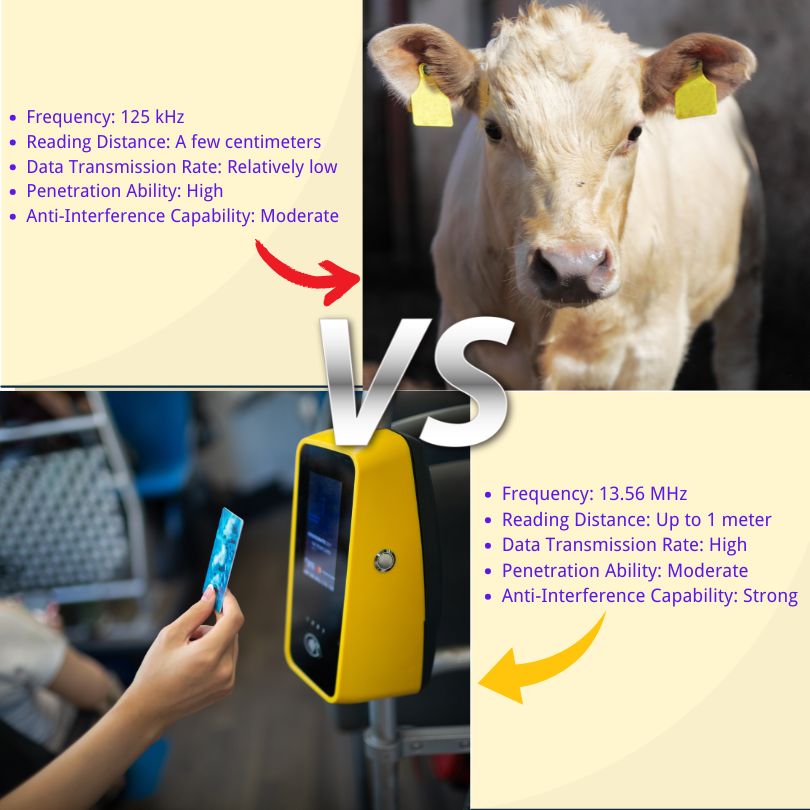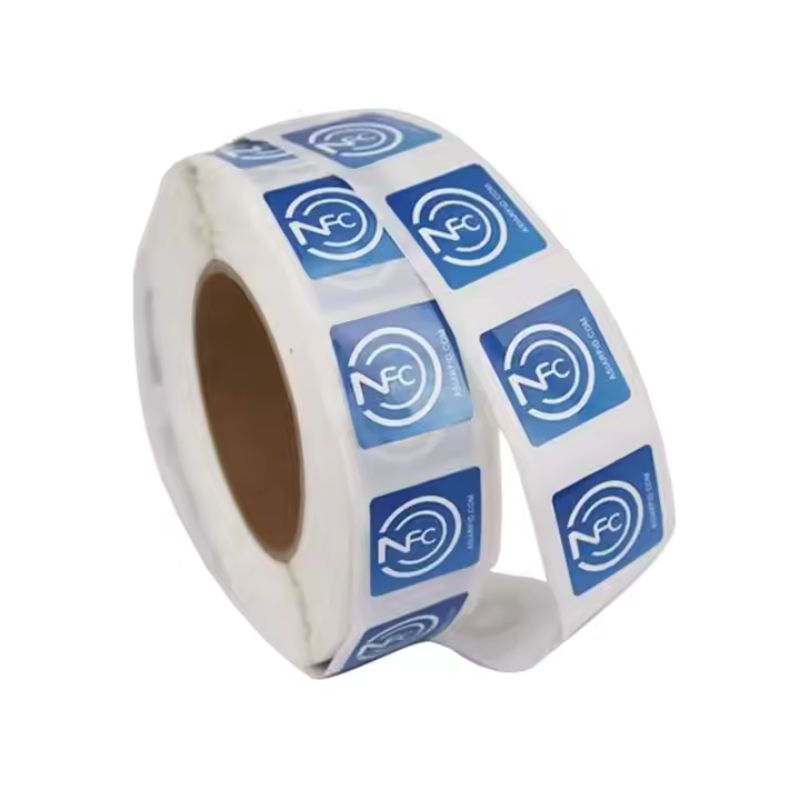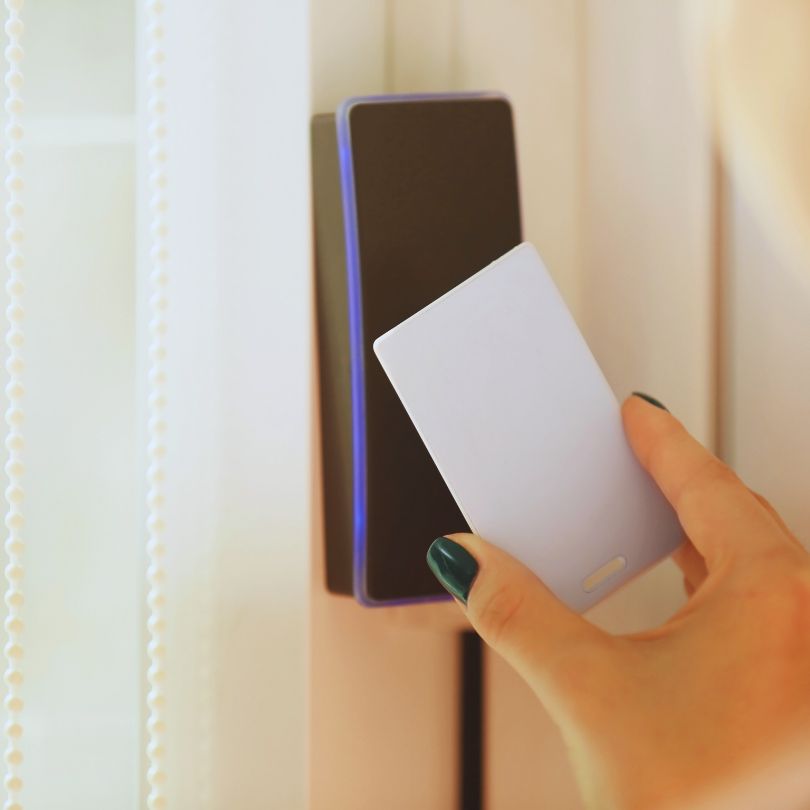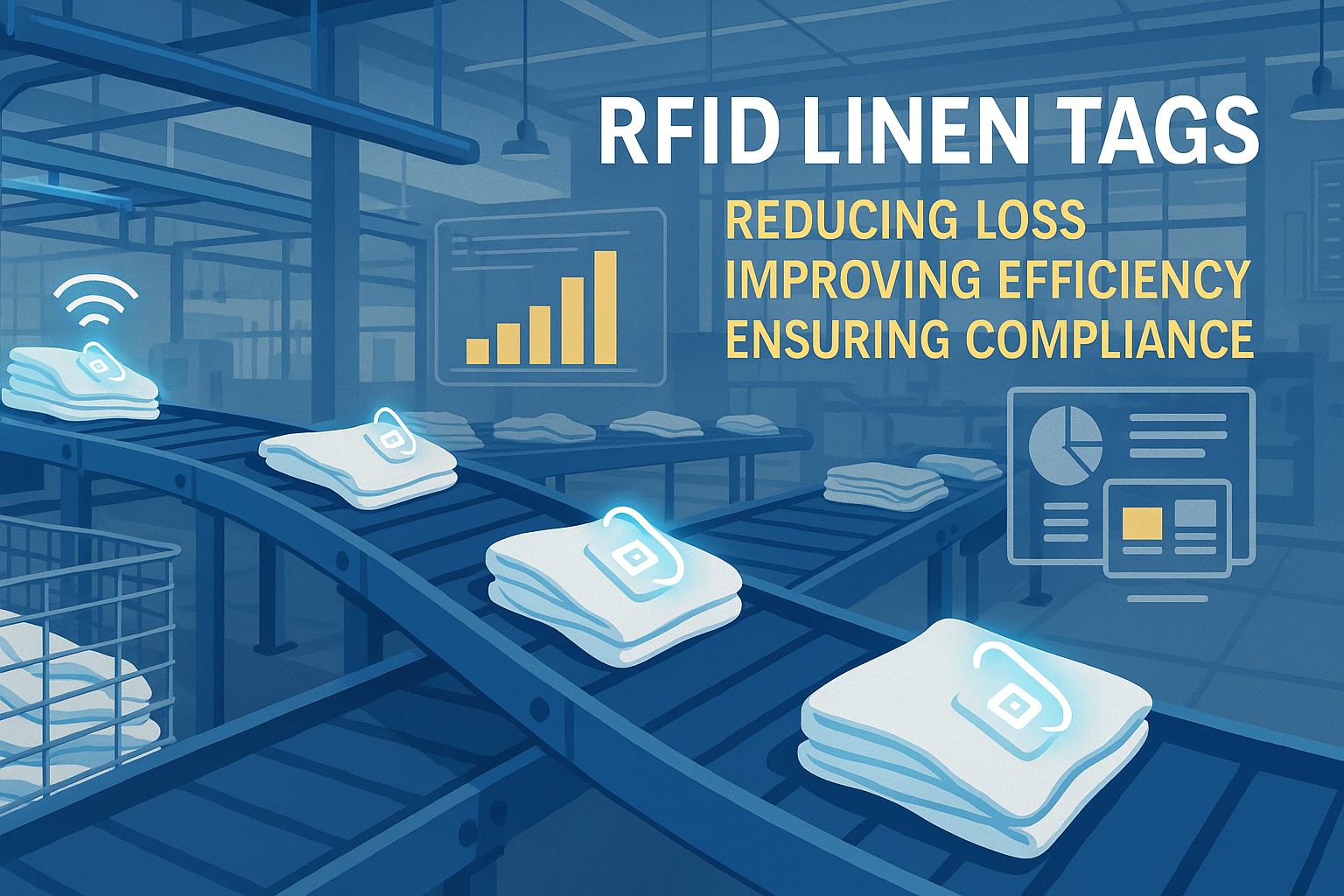
הבנת ההבדלים בין תגי RFID של 13.56 מגה-הרץ ל-125 קילו-הרץ
תוֹכֶן הָעִניָנִים
הבנת ההבדלים בין תגי RFID של 13.56 מגה-הרץ ל-125 קילו-הרץ

מה המשמעות האמיתית של תדר RFID (LF לעומת HF)
מערכות RFID משתמשות בגלי רדיו לתקשורת בין תגים וקוראים. התדר שבו הם משתמשים משפיע על טווח הקריאה שלהם, על מהירות העברת הנתונים, על התנהגותם בסביבת מתכת או מים, ועל סוג הנתונים שהם יכולים לאחסן.
הנה הרעיון המרכזי:
תגי RFID בתדר נמוך (LF) = 125 kHz
- טווח קצר
- קצב נתונים איטי יותר
- ביצועים מצוינים בקרבת מתכת או נוזלים
- פשוט, עמיד וזול
תדר גבוה (HF) = תגי RFID 13.56 מגה-הרץ - טווח ארוך יותר
- קצב נתונים מהיר יותר
- אבטחה מתקדמת יותר
- תואם ל-NFC ולסמארטפונים
13.56 MHz לעומת 125 kHz
| תכונה | תגי RFID 13.56 מגה-הרץ | תגי RFID של 125 קילוהרץ |
|---|---|---|
| תֶדֶר | 13.56 מגה-הרץ (HF) | 125 קילוהרץ (LF) |
| קרא טווח | עד 1 מטר | 2–10 ס"מ |
| קצב העברת נתונים | גָבוֹהַ | נָמוּך |
| ביצועים ליד מתכת | לְמַתֵן | חָזָק |
| בִּטָחוֹן | תומך בהצפנה, אימות הדדי | בסיסי, בדרך כלל ללא הצפנה |
| תמיכה ב-NFC / סמארטפון | כֵּן | לֹא |
| עֲלוּת | גבוה יותר | לְהוֹרִיד |

אבטחה: האם תדר אחד בטוח יותר?
תגי RFID של 125 קילוהרץ משמשים לעתים קרובות במערכות ישנות יותר, ובדרך כלל משתמשים במזהים ייחודיים קבועים ללא הצפנה. זה מקל על שכפולם באמצעות מכשירים זמינים בשוק. הם מתאימים למערכות בעלות סיכון נמוך, אך אינם עומדים בסטנדרטים המודרניים של אבטחה.
תגי RFID בתדר 13.56 MHz, במיוחד כרטיסי MIFARE או DESFire, תומכים ב:
- הצפנה
- אימות הדדי
- אחסון זיכרון מאובטח
- יישומים מרובים בכרטיס אחד
בשורה התחתונה: - השתמש בתגי RFID בתדר 125 kHz לצרכים הדורשים אבטחה נמוכה (כגון מפתחות למתקני אחסון, שעוני נוכחות).
- בחר 13.56 MHz לבקרת גישה, תשלומים או כל מערכת המאחסנת נתונים אישיים.
תאימות NFC וסמארטפונים
אם הפרויקט שלך כולל טלפונים, תגי RFID בתדר 125 kHz לא יעבדו.
רק תגי RFID 13.56 מגה-הרץ תמיכה ב-NFC (Near Field Communication) — הטכנולוגיה המשמשת בתשלומים ניידים, צ'ק-אין ותכונות "הקש כדי להתחבר".
רוב הסמארטפונים יכולים לקרוא ולכתוב תגי NFC בתדר 13.56 MHz, מה שהופך תדר זה לאידיאלי עבור:
- כרטיסים דיגיטליים
- רישום לאירועים
- פוסטרים חכמות
- כרטיסי נאמנות
- זיהוי סלולרי ללא מגע
אם תמיכה בסמארטפונים חשובה לכם, 13.56 MHz היא הבחירה היחידה שלכם.
דוגמאות לשימוש בעולם האמיתי לפי ענף
| תעשייה / יישום | תגי RFID של 125 קילוהרץ | תגי RFID 13.56 מגה-הרץ |
|---|---|---|
| בקרת גישה | מערכות כניסה בסיסיות, דלתות ישנות | אישורים מאובטחים, תגי זיהוי מודרניים |
| תחבורה ציבורית / כרטיסים | לא נתמך | כרטיסי נסיעה מבוססי MIFARE/NFC |
| מעקב אחר בעלי חיים | נמצא בשימוש נרחב בשל חדירתו לרקמות | נדיר |
| אוטומציה תעשייתית | אמין בקרבת מתכת/נוזלים, לשימוש בתנאים קשים | פחות נפוץ בסביבות קשות |
| שירותי בריאות | לא אידיאלי למעקב אחר מטופלים או תרופות | טוב יותר עבור זיהוי מאובטח ותיוג נכסים |
| ספריות / ארכיונים | נדיר | פופולרי למעקב אחר ספרים והשאלות |
| שיווק / אירועים | לא רלוונטי | כרזות חכמות, כרטיסי כניסה לאירועים עם טכנולוגיית NFC |
| אמצעי נגד גניבת רכב | תגי RFID מוטמעים בתדר 125 kHz במפתחות/הצתות | לא בשימוש |

כיצד לבחור בין 13.56 MHz ל-125 kHz לפרויקט שלך
השתמש ברשימה זו כדי לצמצם את האפשרויות:
1. רמת אבטחה
- זקוק להצפנה או לגישה מאובטחת? → בחר ב-13.56 MHz
- מעקב בסיכון נמוך או זיהוי בסיסי? → 125 kHz עשוי להספיק.
2. סביבה
- הפרעות רבות, מתכת או נוזלים בקרבת מקום? → 125 kHz עובד טוב יותר
- משרד נקי או חלל פנימי? → שניהם מתאימים; בחרו בהתאם לתכונות.
3. שילוב סמארטפונים
- רוצים שהמשתמשים יסרקו באמצעות הטלפונים שלהם? → רק 13.56 MHz תומך בכך.
4. תקציב
- תגי 125 kHz זולים יותר מראש
- אבל 13.56 MHz מציע ערך רב יותר בטווח הארוך אם אתם זקוקים לתכונות או לאבטחה.
עדיין משתמשים בתגי RFID בתדר 125 kHz? לשדרג או להישאר?
תגי RFID בתדר 125 kHz עדיין נמצאים בשימוש נרחב ב:
- מערכות בקרת גישה מסורתיות
- פעולות רצפת הייצור
- סימון בעלי חיים
- מערכות נגד גניבה לרכב
אבל אם אתה מצליח: - אישורי הסמכה של הצוות
- מערכות תשלום
- כרטיסי זיהוי רב-שימושיים
- שילוב NFC
...אז אולי הגיע הזמן להחליף.
נתיבי שדרוג:
- התקן קוראי תדרים כפולים
- הנפקת כרטיסי קומבו (תמיכה הן ב-13.56 MHz והן ב-125 kHz)
- השקה הדרגתית: תמיכה בשני המערכות במהלך המעבר
שאלות נפוצות אודות RFID בתדר 13.56 MHz לעומת 125 kHz
האם 13.56 MHz זהה ל-NFC?
כן, NFC הוא סוג של RFID בתדר 13.56 MHz. רוב הסמארטפונים תומכים בו.
האם קורא אחד יכול לקרוא את שני התדרים?
בדרך כלל לא. תזדקק לקורא בעל טכנולוגיה כפולה כדי לטפל בשניהם.
איזה תגית בעלת טווח ארוך יותר?
13.56 MHz בדרך כלל בעל טווח קריאה ארוך יותר (עד 1 מטר). 125 kHz מוגבל לכמה סנטימטרים.
מה עליי להשתמש לצורך בקרת גישה?
למערכות גישה מודרניות ובטוחות, מומלץ מאוד להשתמש בתדר 13.56 MHz.
מדוע לתגי RFID של 13.56 מגה-הרץ ו-125 קילו-הרץ יש מרחקי קריאה שונים?
ההבדל במרחקי הקריאה נובע בעיקר מתדירות הפעולה. לתדרים גבוהים יותר כמו 13.56 מגה-הרץ יש טווח גדול יותר, בעוד שתדרים נמוכים יותר כמו 125 קילו-הרץ מותאמים למרחקים קצרים יותר.
איזה תג RFID מתאים יותר לסביבות מתכת או נוזל?
תגי RFID של 125 קילו-הרץ יעילים יותר בסביבות עם מתכות או נוזלים בשל יכולות החדירה המעולות שלהם.
האם העלות של תגי RFID משפיעה על הבחירה?
כן, תגי RFID של 125 קילו-הרץ הם בדרך כלל חסכוניים יותר, מה שהופך אותם לאופציה מתאימה עבור יישומים עם תקציב. עם זאת, הבחירה צריכה לשקול גם דרישות ביצועים וסביבות יישומים.
תקנים עיקריים וסוגי שבבים
13.56 מגה-הרץ (HF)
- ISO/IEC 14443: משמש בכרטיסים ללא מגע (MIFARE, DESFire)
- ISO/IEC 15693: טווח ארוך יותר, משמש בספריות, לוגיסטיקה
- ISO 18000-3: מעקב ברמת הפריט
125 קילוהרץ (LF)
- פורמטים קנייניים, לרוב עם זיהוי קבוע (לדוגמה, EM4100, HID Prox)
- משמש בעיקר במערכות ישנות וביישומים בסיסיים
מסקנות סופיות
אם אתם עדיין מתלבטים לאיזה כיוון ללכת, הנה סיכום:
השתמש בתגי RFID בתדר 125 kHz עבור:
- תנאים קשים (מתכת/נוזל)
- יישומים בעלי אבטחה נמוכה
- פריסות חסכוניות
- מערכות ישנות
השתמש בתגי RFID בתדר 13.56 MHz עבור:
- תמיכה במובייל/NFC
- גישה ותשלום מאובטחים
- כרטיסים רב-שימושיים
- מערכות מוכנות לעתיד
לשניהם יש מקום — אך עליך לבחור בהתאם לשימוש, ולא רק על סמך עלות או הרגל.
הערות
מוצרים לוהטים

מהו ניהול פסולת באמצעות RFID
דמיינו עיר שבה כל פח אשפה מדבר — לא במובן המילולי — אלא באמצעות שבב זעיר שמודיע למערכת מתי הוא מלא, מתי הוא מרוקן ולאן הוא נלקח. זה מה שעושה כיום ניהול פסולת באמצעות RFID.

מהם אטמי בורג ומהן היישומים שלהם? | המדריך המלא
בסחר ולוגיסטיקה גלובליים, אטמי בורג ממלאים תפקיד מכריע בהבטחת אבטחת המטען ותאימותו. מכשירים קטנים אך עוצמתיים אלה נועדו לנעול מכולות משלוח, נגררים ודלתות מטען באמצעות מנגנון המונע חבלה.

מהו מגן כרטיס RFID? יתרונות, דוגמאות לשימוש ומדריך לקנייה
טכנולוגיית RFID (זיהוי בתדר רדיו) נמצאת בכל מקום: בכרטיסי האשראי, בתגי זיהוי, בכרטיסי נסיעה, במפתחות לחדרי מלון ועוד. היא מציעה מהירות ונוחות, אך היא גם פותחת את הדלת לסוג חדש של גניבה דיגיטלית המכונה “סקים”. כאן נכנס לתמונה מגן כרטיסי RFID.

צמידי RFID לאירועים: מדריך לרכישה בכמויות גדולות למארגנים
צמידי RFID לאירועים הופכים לפתרון המועדף על מארגנים הזקוקים לכניסה מהירה יותר, למניעת הונאות ולתשלומים ללא מזומן בקונצרטים, בפסטיבלים ובאצטדיוני ספורט. בניגוד לכרטיסים מנייר או לקודי QR, צמידים חכמים אלה משתמשים בשבבים מוטמעים כדי לייעל את הגישה, לאבטח את העסקאות ולשפר את חוויית האורחים.

כיצד תג RFID על השמשה הקדמית משפר את בקרת הגישה לרכב ומערכות האגרה
בעולם המהיר של ימינו, זיהוי כלי רכב צריך להיות מהיר, מאובטח וללא מגע. תג RFID על השמשה הקדמית מספק בדיוק את זה — דרך אמינה לנהל גביית אגרה, חניה וגישה לשערים מבלי לעצור את כלי הרכב.

היתרונות של תגי RFID למצעים במכבסות מסחריות
ניהול כביסה בבתי חולים, בתי מלון או שירותי כביסה גדולים הוא משימה לא פשוטה. מדי יום, אלפי סדינים, מגבות ומדים מכובסים, ממוינים ונשלחים בחזרה. אך בעיות כמו אובדן מצעים, טעויות במיון וספירה ידנית עלולות לעלות לחברות הרבה כסף. לדוגמה, בתי מלון בינוניים עלולים להפסיד מעל $200,000 מדי שנה בגלל מצעים שאבדו.
זה המקום שבו תגי RFID לבדים נכנסים לתמונה.
תגים
בלוגים קשורים

מהו ניהול פסולת באמצעות RFID
דמיינו עיר שבה כל פח אשפה מדבר — לא במובן המילולי — אלא באמצעות שבב זעיר שמודיע למערכת מתי הוא מלא, מתי הוא מרוקן ולאן הוא נלקח. זה מה שעושה כיום ניהול פסולת באמצעות RFID.

מהם אטמי בורג ומהן היישומים שלהם? | המדריך המלא
בסחר ולוגיסטיקה גלובליים, אטמי בורג ממלאים תפקיד מכריע בהבטחת אבטחת המטען ותאימותו. מכשירים קטנים אך עוצמתיים אלה נועדו לנעול מכולות משלוח, נגררים ודלתות מטען באמצעות מנגנון המונע חבלה.

מהו מגן כרטיס RFID? יתרונות, דוגמאות לשימוש ומדריך לקנייה
טכנולוגיית RFID (זיהוי בתדר רדיו) נמצאת בכל מקום: בכרטיסי האשראי, בתגי זיהוי, בכרטיסי נסיעה, במפתחות לחדרי מלון ועוד. היא מציעה מהירות ונוחות, אך היא גם פותחת את הדלת לסוג חדש של גניבה דיגיטלית המכונה “סקים”. כאן נכנס לתמונה מגן כרטיסי RFID.




